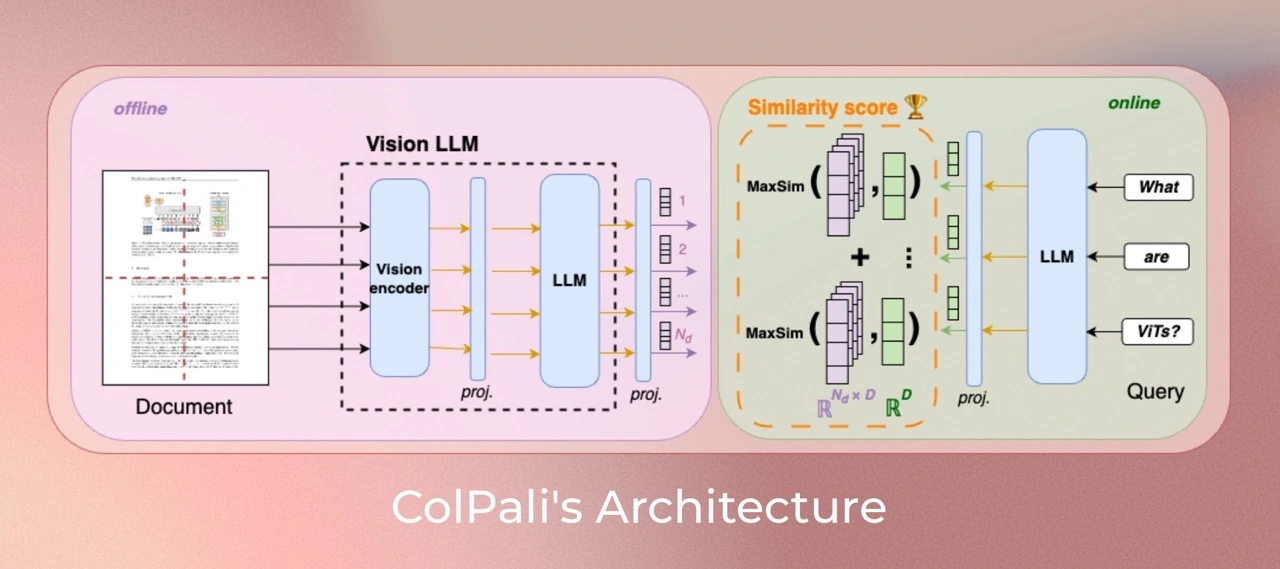Model Overview
Model Features
Model Capabilities
Use Cases
🚀 ColPali: Visual Retriever based on PaliGemma-3B with ColBERT strategy
ColPali is a model that leverages a novel model architecture and training strategy based on Vision Language Models (VLMs). It can efficiently index documents using their visual features. It extends PaliGemma-3B and generates ColBERT-style multi-vector representations of text and images. This model was introduced in the paper ColPali: Efficient Document Retrieval with Vision Language Models and first released in this repository.

🚀 Quick Start
ColPali is a powerful model for visual document retrieval. It builds on the foundation of Vision Language Models (VLMs) to offer efficient document indexing from visual features.
✨ Features
- Novel Architecture: Based on a novel model architecture and training strategy for efficient document indexing.
- Multi - vector Representations: Generates ColBERT-style multi-vector representations of text and images.
- Research - Backed: Introduced in the paper ColPali: Efficient Document Retrieval with Vision Language Models.
📦 Installation
The README does not provide specific installation steps, so this section is skipped.
💻 Usage Examples
Basic Usage
import torch
import typer
from torch.utils.data import DataLoader
from tqdm import tqdm
from transformers import AutoProcessor
from PIL import Image
from colpali_engine.models.paligemma_colbert_architecture import ColPali
from colpali_engine.trainer.retrieval_evaluator import CustomEvaluator
from colpali_engine.utils.colpali_processing_utils import process_images, process_queries
from colpali_engine.utils.image_from_page_utils import load_from_dataset
def main() -> None:
"""Example script to run inference with ColPali"""
# Load model
model_name = "vidore/colpali-v1.1"
model = ColPali.from_pretrained("vidore/colpaligemma-3b-mix-448-base", torch_dtype=torch.bfloat16, device_map="cuda").eval()
model.load_adapter(model_name)
model = model.eval()
processor = AutoProcessor.from_pretrained(model_name)
# select images -> load_from_pdf(<pdf_path>), load_from_image_urls(["<url_1>"]), load_from_dataset(<path>)
images = load_from_dataset("vidore/docvqa_test_subsampled")
queries = ["From which university does James V. Fiorca come ?", "Who is the japanese prime minister?"]
# run inference - docs
dataloader = DataLoader(
images,
batch_size=4,
shuffle=False,
collate_fn=lambda x: process_images(processor, x),
)
ds = []
for batch_doc in tqdm(dataloader):
with torch.no_grad():
batch_doc = {k: v.to(model.device) for k, v in batch_doc.items()}
embeddings_doc = model(**batch_doc)
ds.extend(list(torch.unbind(embeddings_doc.to("cpu"))))
# run inference - queries
dataloader = DataLoader(
queries,
batch_size=4,
shuffle=False,
collate_fn=lambda x: process_queries(processor, x, Image.new("RGB", (448, 448), (255, 255, 255))),
)
qs = []
for batch_query in dataloader:
with torch.no_grad():
batch_query = {k: v.to(model.device) for k, v in batch_query.items()}
embeddings_query = model(**batch_query)
qs.extend(list(torch.unbind(embeddings_query.to("cpu"))))
# run evaluation
retriever_evaluator = CustomEvaluator(is_multi_vector=True)
scores = retriever_evaluator.evaluate(qs, ds)
print(scores.argmax(axis=1))
if __name__ == "__main__":
typer.run(main)
Advanced Usage
# If you need to further train ColPali from this adapter, you should run:
lora_config = LoraConfig.from_pretrained("vidore/colpali-v1.1")
lora_config.inference_mode = False # force training mode for fine-tuning
model = get_peft_model(model, lora_config)
print("after")
model.print_trainable_parameters()
📚 Documentation
Version specificity
This version is trained with colpali-engine==0.2.0. Compared to colpali, it is trained with right padding for queries to fix unwanted tokens in the query encoding. It also stems from the fixed vidore/colpaligemma-3b-mix-448-base to guarantee deterministic projection layer initialization. The data is the same as the ColPali data described in the paper.
Model Description
This model is iteratively built starting from an off - the - shelf SigLIP model. It is finetuned to create BiSigLIP, and the patch - embeddings output by SigLIP are fed to an LLM, PaliGemma-3B to create BiPali. Inputting image patch embeddings through a language model maps them to a latent space similar to textual input (query), enabling the use of the ColBERT strategy to compute interactions between text tokens and image patches, which improves performance compared to BiPali.
Model Training
Dataset
Our training dataset of 127,460 query - page pairs consists of train sets from openly available academic datasets (63%) and a synthetic dataset made up of pages from web - crawled PDF documents and augmented with VLM - generated (Claude - 3 Sonnet) pseudo - questions (37%). The training set is fully English, allowing us to study zero - shot generalization to non - English languages. We ensure no multi - page PDF document is used in both ViDoRe and the train set to prevent evaluation contamination. A validation set is created with 2% of the samples to tune hyperparameters.
Note: Multilingual data is present in the pretraining corpus of the language model (Gemma - 2B) and may occur during PaliGemma - 3B's multimodal training.
Parameters
All models are trained for 1 epoch on the train set. Unless otherwise specified, we train models in bfloat16 format, use low - rank adapters (LoRA) with alpha = 32 and r = 32 on the transformer layers from the language model, as well as the final randomly initialized projection layer, and use a paged_adamw_8bit optimizer. We train on an 8 GPU setup with data parallelism, a learning rate of 5e - 5 with linear decay and 2.5% warmup steps, and a batch size of 32.
🔧 Technical Details
- Focus: The model mainly focuses on PDF - type documents and high - resources languages, which may limit its generalization to other document types or less represented languages.
- Support: The model relies on multi - vector retrieval derived from the ColBERT late interaction mechanism. Adapting it to widely used vector retrieval frameworks without native multi - vector support may require engineering efforts.
📄 License
ColPali's vision language backbone model (PaliGemma) is under gemma license as specified in its model card. The adapters attached to the model are under MIT license.
Contact
- Manuel Faysse: manuel.faysse@illuin.tech
- Hugues Sibille: hugues.sibille@illuin.tech
- Tony Wu: tony.wu@illuin.tech
Citation
If you use any datasets or models from this organization in your research, please cite the original dataset as follows:
@misc{faysse2024colpaliefficientdocumentretrieval,
title={ColPali: Efficient Document Retrieval with Vision Language Models},
author={Manuel Faysse and Hugues Sibille and Tony Wu and Bilel Omrani and Gautier Viaud and Céline Hudelot and Pierre Colombo},
year={2024},
eprint={2407.01449},
archivePrefix={arXiv},
primaryClass={cs.IR},
url={https://arxiv.org/abs/2407.01449},
}
 Transformers
Transformers Transformers English
Transformers English Transformers
Transformers Transformers
Transformers Transformers
Transformers Transformers
Transformers Transformers Supports Multiple Languages
Transformers Supports Multiple Languages Transformers
Transformers